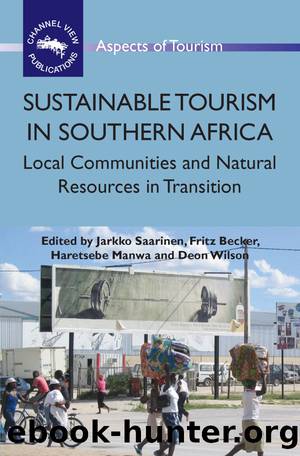Sustainable Tourism in Southern Africa by Saarinen Jarkko;Becker Fritz O.;Manwa Haretsebe;Wilson Deon;

Author:Saarinen, Jarkko;Becker, Fritz O.;Manwa, Haretsebe;Wilson, Deon;
Language: eng
Format: epub
Publisher: Channel View Publications, Limited
Published: 2009-08-15T00:00:00+00:00
Utilization and Management of Landforms as Tourism Resources
Landscapes and landforms in tourism have diverse meanings, and may be used for recreation and business. It is thus of interest to consider the âemotional meanings that people attach to environmentsâ (Waitt et al., 2003: 526), while Mehmetoglu (2007: 652) points to âexperiences that are dependent on nature, experiences that are enhanced by nature and experiences for which nature is incidental.â In addition, landscapes are sites of scientific investigation, as the mode of their formation, hence their sustainability are also key. Crofts (1975) analysed the various preference techniques (scenic quality, attractiveness or aesthetics) used in landscape evaluation and noted their subjectivity. These beauty judgments may depend on the individual surveyor's experience, culture, the discipline or training background. Thus, scenic quality assessments may benefit from (improved) randomly selected individuals and groups. Deng et al. (2002) indicated attractiveness of parks as enhanced by tourism resources, tourist facilities, accessibility, local communities and peripheral attractions. According to Waitt et al. (2003), there are malleable boundaries that define nature, such that touristic experiences may not differentiate between large tracts of irrigated agriculture from physical and biological processes. That âlandscapes become attractions through the meanings that are ascribed to them by promotional agencies and touristsâ (Waitt et al., 2003: 524), thus tourists being mere dependents of the tourism brochures. This may have challenges for the validity of nature-based tourism â a wilderness trail (of emotional values and meanings ascribed to landscapes) or ecotouristic responsibilities for both visitor and local communities (where social, economic and environmental benefits accrue to all) or a combination of all the above.
It is noted that, resources may directly or indirectly satisfy human needs. In addition, a resource need not only be seen in terms of human utilization â that the intrinsic values of resources are realized. For instance, climate regulation, soil formation, plants pollination and energy transfer are some of the intrinsic functions that do not need any human utilization aspects â they are normal functions of landscapes and ecosystems. Tourism as a field of study takes on board both the human and non-human values, for example, economic or business ventures that may arise out of tourist operations; as well as promoting conservation of species, landscapes and habitats. Some of the sites to be preserved and/or conserved may relate to spiritual, cultural, scientific and genetic resources. Thus the religious, heritage, historic, medicinal and use of nature for scientific research are some of the natural values of ecosystems and landscapes (Table 8.2).
The land resources policies in Botswana operate to sustain the natural resources. Thus the exploitation is aimed at promoting resource use in an environmentally benign manner. For instance, Saarinen (2006) has noted some of the impacts of tourism to have led to various actual and potential problems that may be social, political, environmental, cultural and economic for destinations and systems. This, he argues, create a need for alternative and friendlier practices (environmentally and to the hosts) in decision-making processes in development, planning and the policies (Box 8.
Download
This site does not store any files on its server. We only index and link to content provided by other sites. Please contact the content providers to delete copyright contents if any and email us, we'll remove relevant links or contents immediately.
Man-made Catastrophes and Risk Information Concealment by Dmitry Chernov & Didier Sornette(5650)
The Revenge of Geography: What the Map Tells Us About Coming Conflicts and the Battle Against Fate by Kaplan Robert D(3961)
Zero Waste Home by Bea Johnson(3655)
In a Sunburned Country by Bill Bryson(3368)
COSMOS by Carl Sagan(3348)
Good by S. Walden(3347)
The Fate of Rome: Climate, Disease, and the End of an Empire (The Princeton History of the Ancient World) by Kyle Harper(2873)
Camino Island by John Grisham(2719)
A Wilder Time by William E. Glassley(2690)
Organic Mushroom Farming and Mycoremediation by Tradd Cotter(2567)
The Ogre by Doug Scott(2501)
Human Dynamics Research in Smart and Connected Communities by Shih-Lung Shaw & Daniel Sui(2431)
Energy Myths and Realities by Vaclav Smil(2380)
The Traveler's Gift by Andy Andrews(2299)
9781803241661-PYTHON FOR ARCGIS PRO by Unknown(2269)
Inside the Middle East by Avi Melamed(2230)
Birds of New Guinea by Pratt Thane K.; Beehler Bruce M.; Anderton John C(2175)
A History of Warfare by John Keegan(2105)
Ultimate Navigation Manual by Lyle Brotherton(2048)
